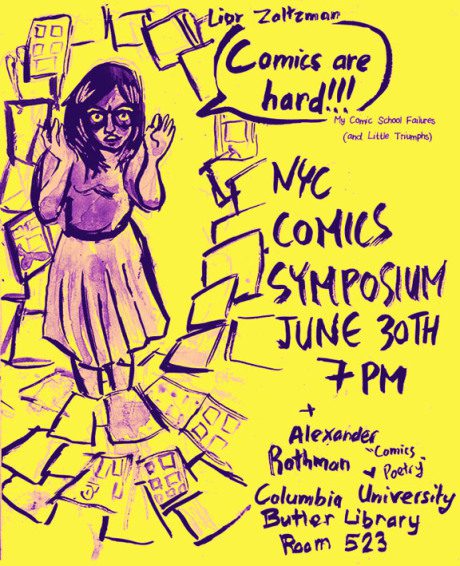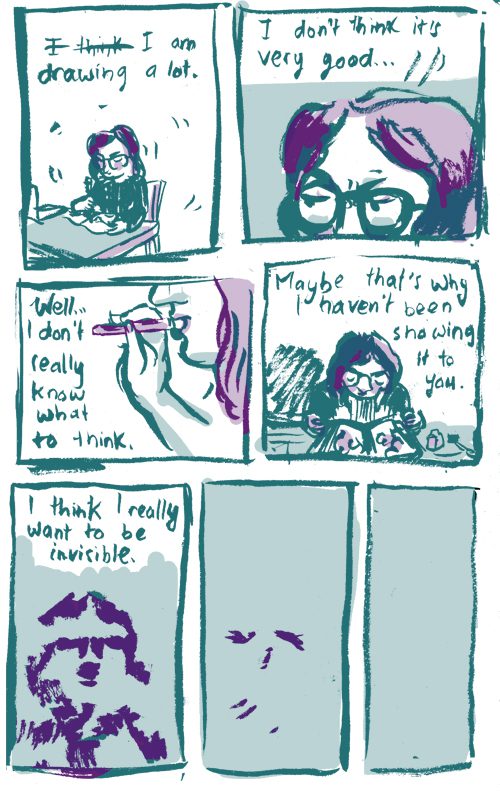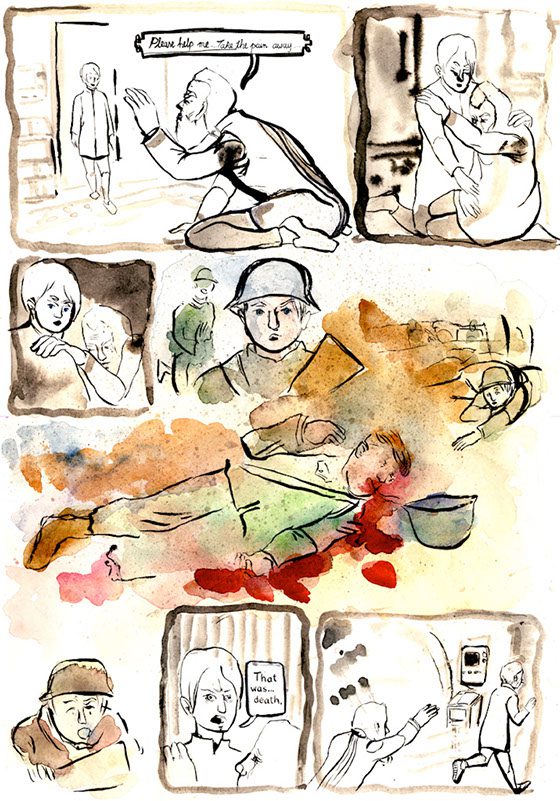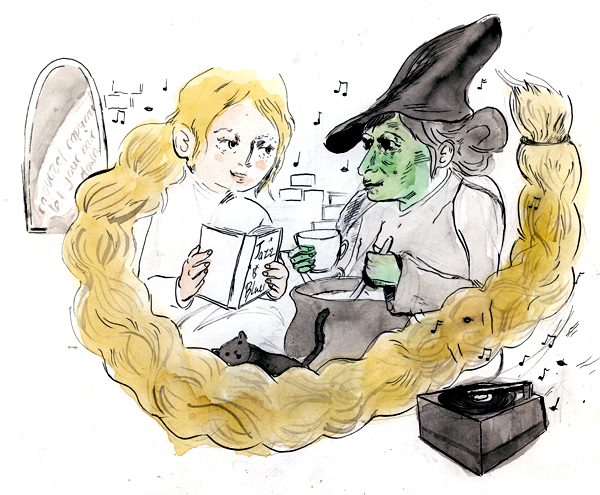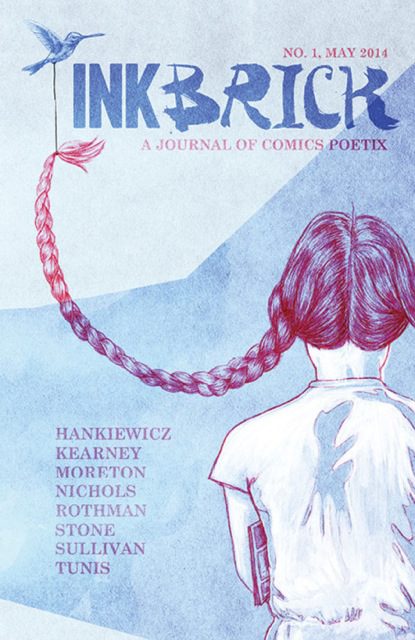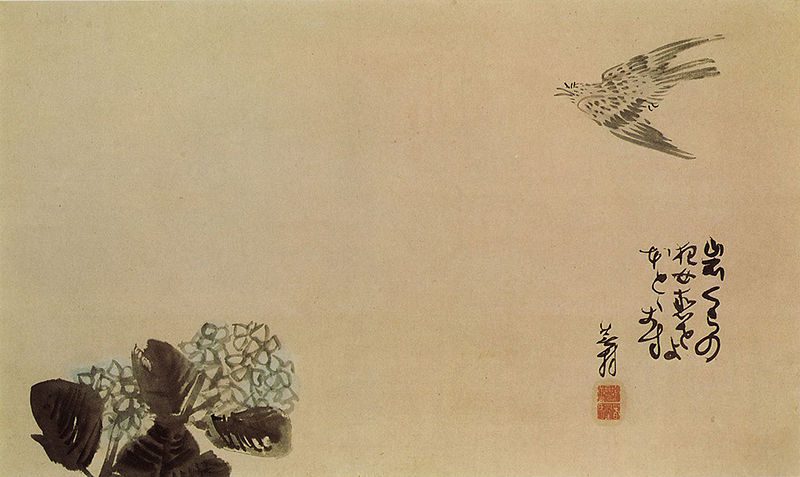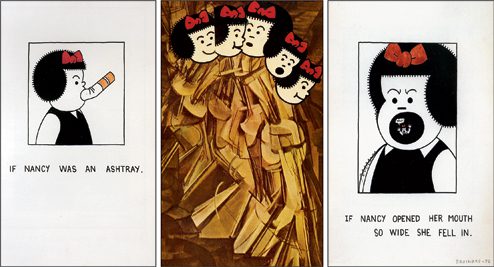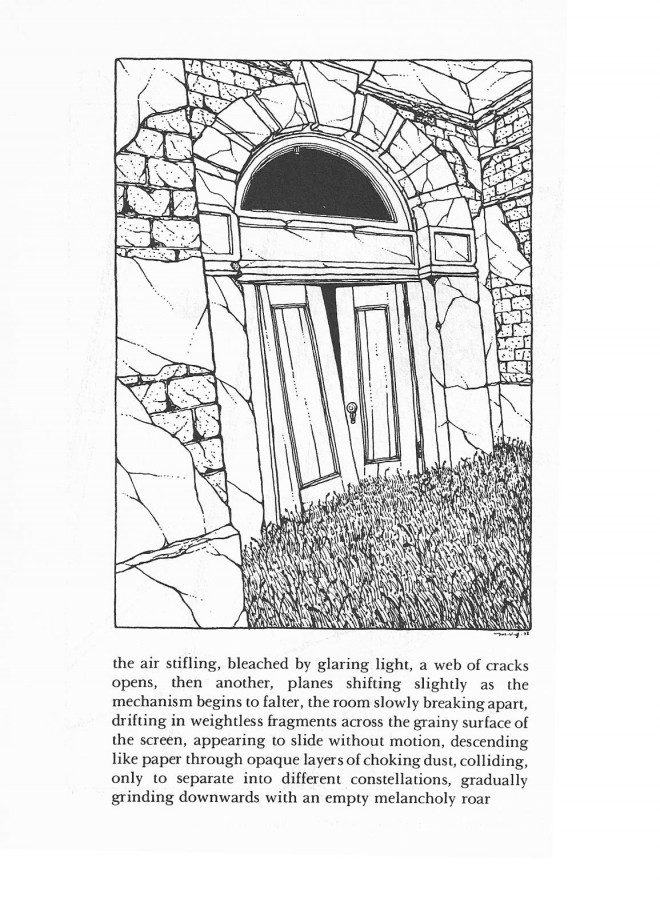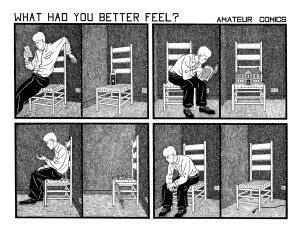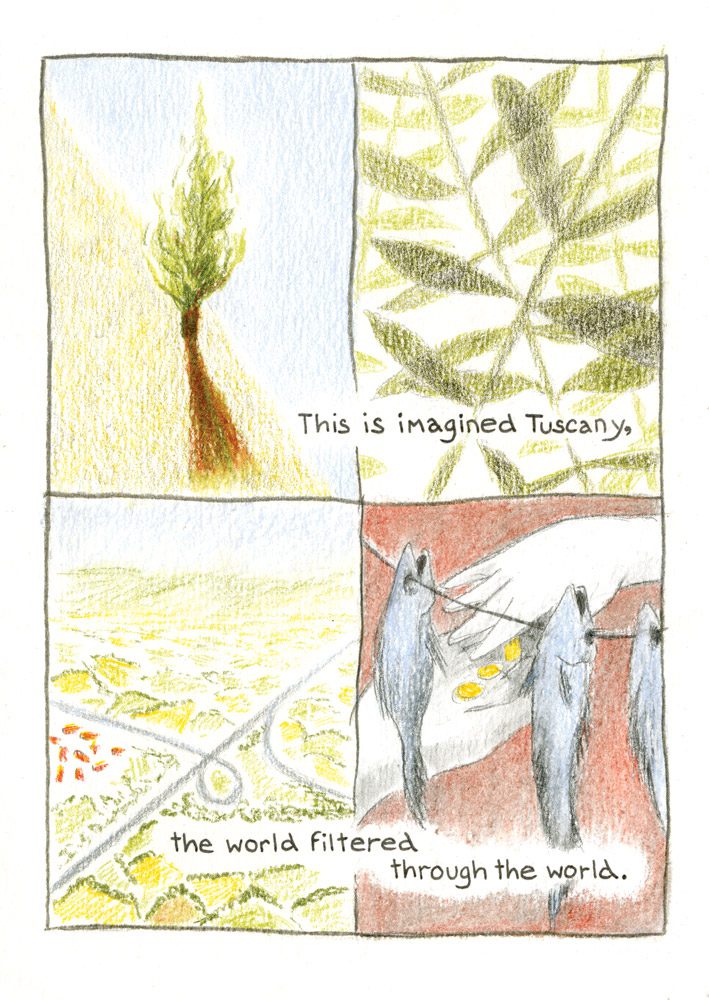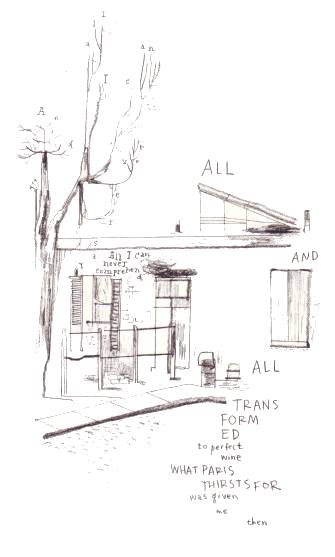The New York Comics & Picture-Story Symposium is a weekly forum for discussing the tradition and future of text/image work. Open to the public, it meets Monday nights at 7-9 p.m. EST in New York City. Presentations vary weekly and include everything from historical topics and technical demonstrations to creators presenting their work. Check out upcoming meetings here.
On Monday, June 30th, at the 90th New York Comics Symposium, the cartoonist Lior Zaltzman presented on her experience at the School of Visual Arts’s Cartooning program and the cartoonist and editor Alexander Rothman gave a presentation on the definition, history, and future of poetry comics.
*
Lior Zaltzman started the symposium with her talk entitled “Comix Are Hard: My Comic School ‘Failures’ (and Little Triumphs).” Zaltzman was born in Israel, but as a child her family moved to Brussels, Belgium. She described herself as a shy and nervous child and so moving to a new country was difficult, but it was then that she found the comfort of escape that comics could provide—as she said, “Tin-tin saved my life.”
Attending the SVA cartooning program in New York City was something of a calling for Zaltzman. After she found out about the program, it was all she could think about doing with her life, even though she was halfway around the world attending a high school that did not offer art classes. Her parents thought she would grow out of it, but despite her lack of access to instruction Zaltzman drew all the time. Her work was so admired by classmates that they began stealing her drawings, which Zaltzman took as a huge compliment and boon to her confidence. After high school, she served in the Israeli Army as part of the country’s compulsory military service requirement. When she got out of the army she was still obsessed with making comics, and so her parents finally took her ambitions seriously and supported her application to her dream program.
One of her first teachers was Tom Hart, who introduced her to the narrative arc, a concept Zaltzman found frustrating to incorporate into her emotionally informed comics. Matt Madden and Jessica Abel also stressed the need for structure in her work. Zaltzman was doubly frustrated by the fact that having grown up on ligne claire (“clear line”) art work, she now found that she preferred looser, more gestural mark-making when she drew. All her instincts dictated a soft and free-flowing style while all her professors stressed strict clear artistic and conceptual lines.
She continued to discuss her evolution through the program, her successes and failures, and how she managed to find her own voice within the parameters of a very structured academic environment. For Zaltzman, it was a balancing act of trying to learn her own strengths while taking the best from what the program had to offer. She explained that, though it seems obvious, one of the hardest things about making comics is simply trying to make them make sense. Teachers Nate Powell, Jason Little, Bruce Waldman, and Peter Kuper all played roles in her pursuit of this objective.
Despite the fact that school seemed to be a relentless series of challenges and obstacles, her comic The Giver (based on the Lois Lowry book) won her a scholarship and a place in the school cartooning art show. By her senior year (now under the tutelage of renowned cartoonists Lauren Weinstein and David Mazzucchelli), she resolved to make only the comics she wanted, in the style she wanted. Her senior year ended dramatically, as she married, was hit by a car, and graduated (with honors no less) all within a single month.
In the discussion portion of Zaltzman’s talk, the limitations of the narrative arc were discussed, and it was suggested that it was not a useful approach when writing short (3-6 page) comics. Zaltzman insisted that her attempts to adhere to the arc, regardless of a comic’s length, were beneficial, and compared the techniques imparted to her during her schooling to a toolbox that one can pull from later. For instance, now that Zaltzman is working on a long-form comic, she can exist in a very instinctual mindset, while unconsciously making use of the rules that were ingrained in her by Hart, Abel, and Madden.
*
Alexander Rothman spoke next on the history of comics poetry. He is co-editor-in-chief of Ink Brick, a journal of comics poetry, which he cofounded with Paul K. Tunis, Bianca Stone, and Gary Sullivan. Rothman began by discussing his definition of “comics poetry,” and by sussing out the differences between prose and poetry. He said it is useful to think of these as a categories of language, rather than forms. Prosaic language is strictly communicative and seeks to be unambiguous, like a set of instructions or a manual. Poetic language (which might appear in a “prose” work like a novel) is a heightened language. It is multivalent, ambiguous, and nuanced. Rothman offered the e.e. cummings poem often titled “l(a” or “a leaf falling in loneliness” to demonstrate how a poem can incorporate visual aspects, contain various aspects of wordplay as well as nuanced meanings, and have myriad possible interpretations. If poetry is characterized by elements of language like rhythm, rhyme, literary devices, nontraditional phrasing, and evocative dimensions, then we can seek analogs in comics poetry that relate to comics’ visual language.
Rothman gave several examples of where the line blurs between merely illustrating a poem and beginning to create poetry with imagery itself, such as William Blake’s “The Tyger” and Yosa Buson’s work in haiga, a Japanese tradition of illustrating a haiku with unrelated imagery. For Rothman, George Herriman’s word-loving and onomatopoeic newspaper comic strip Krazy Kat contains within it numerous instances of poetry and visual poetic devices.
As to what comics poetry actually is, Rothman highlighted the work of Joe Brainard, an artist associated with the New York School of poets, who created hundreds of images using the motif of Ernie Bushmiller’s iconic comics character Nancy to riff on fine art, pop-culture, and everything in between. (These works have since been collected as The Nancy Book). In 1964 and 1965, he collaborated with the aforementioned New York School Poets, including Frank O’Hara, Ron Padgett, Barbara Guest, and John Ashbery, to create two anthologies of comics poetry called C: Comics.
The Italian cartoonist Dino Buzatti was also making what could be considered comics poetry in the 1960s and 70s, as was the Canadian cartoonist Martin Vaughn-James. Rothman lingered on Vaughn-James’s book The Cage, which is notable for its absolute lack of human forms and the rambling and often inscrutable text that runs under his haunting drawings.
Rothman’s examples of comics poetry from the 1990s included work by Glenn Dakin, Tom Motley, and Gary Sullivan. Moving into the 2000s, Rothman focused on two major works: John Hankiewicz’s evocative Asthma, and Warren Craghead’s HOW TO BE EVERYWHERE. He suggested that the latter, which draws on poetry by Guillaume Apollinaire, incorporates elements of cubism, assimilating various angles into images and an attempting to see things from many perspectives all at once. Also discussed were Damien Jay’s gorgeous calligraphy-infused work for the anthology Sundays #5, Bianca Stone’s “Because You Love You Fall Apart” and I Want To Open The Mouth God Gave You, Beautiful Mutant, and Paul K. Tunis’s Bruises.
Rothman ended his presentation with slides of his own work, reading previously unseen “What This Is,” a softly rendered and lyrical piece. It will appear in an anthology from Kuš later this summer. He concluded with a “who’s who” list of contemporary comics artists working in comics poetry; among these were Dina Kelberman, David Lasky, Leland Myrick, Sophie Yannow, and Jason Overby, as well as the creators of the comics poetry anthology Linen Ovens, Andrea Tsurumi, Molly Brooks, and Keren Katz (Rothman is also a contributor to the publication).
When the discussion was opened up to the audience, someone brought up abstract comics and how they pursue similar objectives to comics poetry. Rothman sees the two as having similar artistic objectives in some ways, but also as being distinct.
Rothman explained that there is some resistance within the comics scene to the idea of poetry comics, as they are seen by some to be antithetical to the spirit of comics themselves. Comics in many ways embody a DIY and anti-establishment ideology, as Rothman put it: “a coming up from the bottom.” Poetry is seen by some critics as elitist, part of the “academy,” a rarefied and refined world that should have nothing to do with comics. Rothman obviously does not see poetry and comics as mutually exclusive realms, but as worlds that can enhance each other and expand upon the possibilities of both.
***
Image Credits:
Image 1: Lior Zaltzman, Poster for “Comix Are Hard: My Comic School ‘Failures’ (and Little Triumphs)”, 2014
Image 2: Lior Zaltzman, “Invisible”, 2013
Image 3: Lior Zaltzman, excerpt from “The Giver”, 2012
Image 4: Lior Zaltzman, Re-imagined Ending to the story of Rapunzel, 2013
Image 5: Paul K. Tunis, cover for Ink Brick, 2014
Image 6: Yosa Buson, A little cuckoo across a hydrangea, Haiga, 16th century
Image 7: Joe Brainard, pages from The Nancy Book, various dates.
Images 8: Martin Vaughn-James, exceprt from The Cage, 1975
Image 9: John Hankiewicz, excerpt from Asthma, 2006
Image 10: Alexander Rothman, “What This Is”, š! #18, 2014
Image 11: Warren Craghead, HOW TO BE EVERYWHERE, 2007
***
About the author: Sophia Wiedeman is a comic artist and author of The Lettuce Girl series of comics as well as the Xeric-winning graphic novel The Deformitory. She lives and draws in New York City. You can see her work at sophiadraws.com on her tumblr at sophiadraws.tumblr.com and follow her @sophiawiedeman on twitter.

